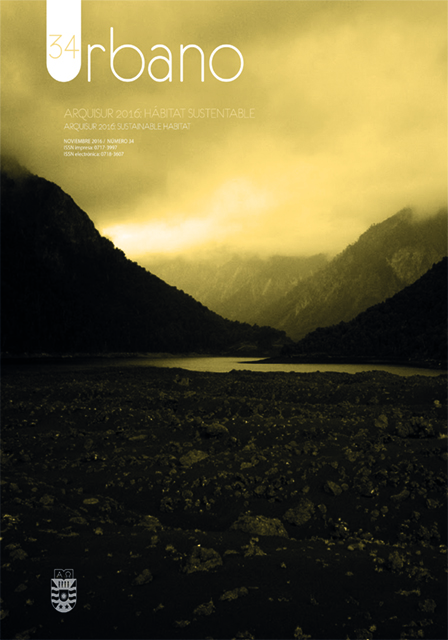The design of urban sustainability indicators: the case of Greater San Juan in Argentina
DOI:
https://doi.org/10.22320/07183607.2016.19.34.1Keywords:
urban development, sustainable development, evaluation, seismic zone, arid zoneAbstract
This paper is part of an ongoing research project whose objective is to contribute to the sustainable urban development of Greater San Juan. For this research, sustainable development is understood to be that which has as core concepts: social equity, economic efficiency and environmental conservation, through the design of a group of urban indicators as tools for permanent, dynamic monitoring. Taking sustainability into consideration in Greater San Juan is imperative due to the fact that it is a seismic oasis city, which means preserving its status as an intermediate city. The study is ordered methodologically into three general stages: exploration and analysis of background information related to the subject, the proposal of a structure that supports the system of indicators with its subsystems, and the design of sustainability condition indicators for the study area. The results obtained in the research project include a system of structured, related indicators based on three subsystems, which pertain to the physical-spatial, socio-cultural and environmental aspects that contain the various sustainability indicators. This article presents a design proposal for some indicators in the physical-spatial subsystem to evaluate Greater San Juan and obtain conclusions as input for reflection.
Downloads
References
Agencia de Ecología Urbana de Barcelona (2011). Sistema de Indicadores y Condicionantes para ciudades Grandes y Medianas. Ministerio de Medio Ambiente y Medio Rural y Marino, España.
BÄR SARDA, Ana (2009). Indicadores de Calidad Ambiental Urbana. Tesis de Máster en Desarrollo Urbano y Territorial [PDF]. UPC. Barcelona.
BELLET, Carmen; LLOP, Josep María (2000). Ciudades intermedias. Urbanización y sostenibilidad. Pagès ed., Lleida. Barcelona, España.
CEPAL (2006).ESALC Evaluación de la Sostenibilidad en América Latina y el Caribe. Disponible en: http://www.eclac.cl/dmaah/proyectos/esalc/
GROSS, Patricio (1998) Ordenamiento territorial. El manejo de los espacios rurales. Revista EURE, Nº 73. Santiago de Chile.
INPRES (1993). www.inpres.gov.ar: La verdadera dimensión del problema sísmico en la Provincia de San Juan. Publicación técnica Nº 18, San Juan, Argentina.
LLOP, Josep Mª. (2013). Medir la sostenibilidad urbana a escalas intermedias: Compacidad-proximidad y habitabilidad-accesibilidad. Revista Catalana de Acceso Abierto: http://www.raco.cat/index.php/Sostenible/article/view/261968
Ministerio de Medio Ambiente y Medio Rural y Marino- Agencia de Ecología Urbana de Barcelona (2010) Publicación del Sistema de Indicadores y Condicionantes para ciudades Grandes y Medianas. Barcelona, España.
NACIF, Nora; ESPINOSA, M dell Pilar; MARTINET, Marta. Miradas Intencionadas: Una Ciudad Oasis de Zona Sísmica. (2012). Revista Iberoamericana de Urbanismo RIURB. Disponible en: http://www.riurb.com/pg_numeros_anteriores_2011_06Dossier_00.html
NACIF, Nora Elsa; ESPINOSA, María del Pilar; MARTINET, Marta Graciela. (2012). Indicadores para la Evaluación de la Sustentabilidad en la Ciudad de San Juan. - Revista ANDINAS – Revista de Estudios Culturales. En Torno a la Arquitectura, el Urbanismo y el Diseño. FAUD - UNSJ.
ONU (2004). Agenda Hábitat: Programa de las Naciones Unidas para los Asentamientos Humanos. Oficina Regional para América Latina y el Caribe. PDF. Disponible en: http://www.onuhabitat.org/index.php
ROITMAN, Dora y otros. (1996). San Juan, La ciudad y el Oasis. Editorial EFU - San Juan, Argentina.
RUEDA PALENZUELA, Salvador (1999). Modelos e Indicadores para ciudades más sostenibles. Departament de Medi Ambient de la Generalitat de Catalunya. Barcelona, España.
RUEDA PALENZUELA, Salvador (2007). Libro Verde de medio ambiente urbano. Ministerio de Medio Ambiente y Agencia de Ecología Urbana de Barcelona. Documento de trabajo PDF • marzo 2007
Secretaria de Ambiente y Desarrollo Sustentable de la Nación. (2010) Sistema de Indicadores de Desarrollo Sostenible. Argentina. Quinta Edición. Documento PDF. Presidencia de la Nación. Buenos Aires, Argentina.
SUVIRES, G. y GAMBOA, L. (2013). Medidas de autosuficiencia social ante el peligro sísmico. Actas del “Congreso Internacional de Riesgos y mitigación de desastres”, pp. 20-28. Catamarca: CIRIDE.
UN, CEPAL, Hábitat (2016). Ciudades sostenibles con igualdad en América Latina y el Caribe: seis mensajes claves. Edit. CEPAL. Colección Libros y monografías. Disponible en http://www.cepal.org/es/publicaciones/40658-ciudades-sostenibles.
Downloads
Published
How to Cite
Issue
Section
License
Copyright (c) 2016 Nora Elsa Nacif

This work is licensed under a Creative Commons Attribution-ShareAlike 4.0 International License.
The content of articles which are published in each edition of Habitat Sustentable, is the exclusive responsibility of the author(s) and does not necessarily represent the thinking or compromise the opinion of University of the Bio-Bio.
The author(s) conserve their copyright and guarantee to the journal, the right of first publication of their work. This will simultaneously be subject to the Creative Commons Recognition License CC BY-SA, which allows others to share-copy, transform or create new materials from this work for non-commercial purposes, as long as they recognize authorship and the first publication in this journal, and its new creations are under a license with the same terms.![]()























